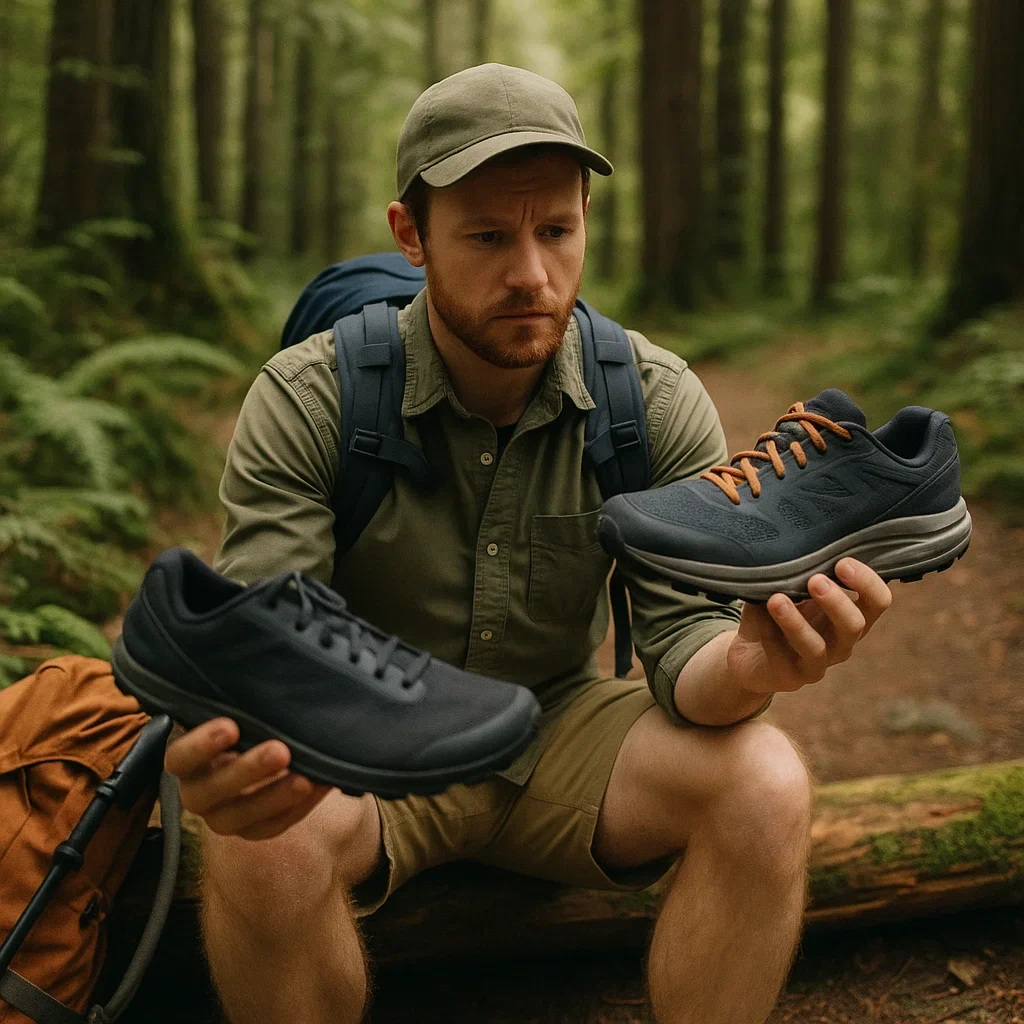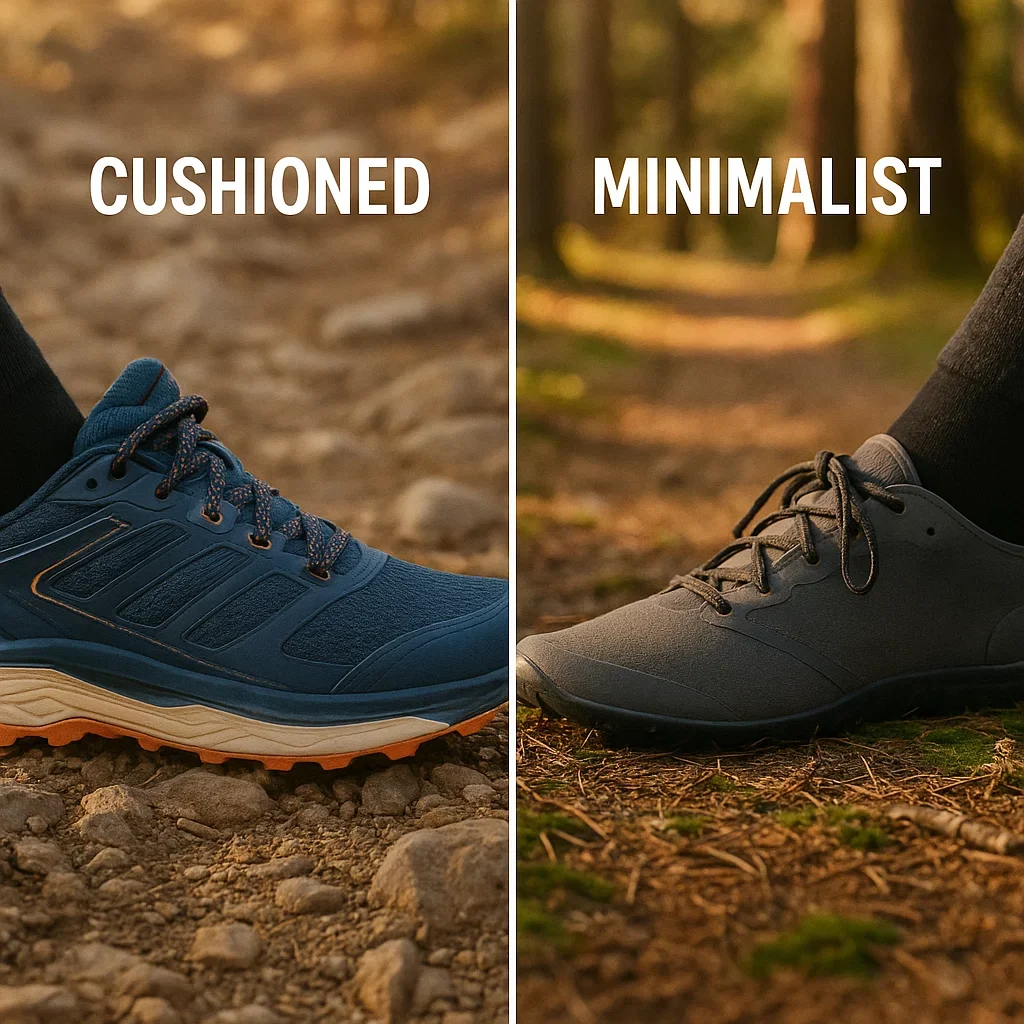Cushion vs Minimal Trail Running Shoes for Hiking
Which is Right for You? 👟🆚🦶
Are you team pillowy comfort or a fan of the barefoot-like ground feel? Whether you’re logging miles on mountain trails or just want to move lighter and faster, choosing between cushioned and minimalist trail running shoes can change your hiking experience entirely.
Not sure where to start? Check our main guide: Best Trail Running Shoes for Hiking
🛏️ What is a Cushioned Trail Running Shoe?
Cushioned trail shoes are designed for maximum comfort and shock absorption. They feature thick midsoles (often 25–38mm), plush foams, and built-in rock plates for underfoot protection. Modern superfoams like PEBA, EVA blends, or compressed PU deliver cloud-like landings—even on rocky ground.
- Who loves them? Hikers with sensitive joints, heavy packers, long-distance trekkers, or anyone craving less soreness after a day on the trail.
- Popular models: Hoka Speedgoat, Brooks Caldera, Nike Pegasus Trail, Altra Olympus.
- Fun fact: Some “max cushion” trail shoes are lighter than older, less-cushioned models—thanks to modern foam tech!

🦶 What is a Minimal Trail Running Shoe?
Minimalist trail shoes deliver ultimate ground feel and freedom. Typically featuring low stack height (under 20mm), ultra-lightweight builds, and flexible soles, they’re designed to mimic barefoot movement, strengthen foot muscles, and allow your toes to splay naturally.
- Key traits: Zero or very low drop (0–4mm), thin outsoles, wide toe boxes.
- Who loves them? Experienced hikers, those seeking agility and natural movement, and fans of “barefoot” philosophy.
- Popular models: Merrell Vapor Glove, Inov-8 Bare-XF, Altra Superior, Vibram FiveFingers.
- Fun fact: Many ultralight backpackers use minimalist shoes for 3-season trails and river crossings.

🔬 Key Differences: Cushion vs Minimal
| Feature | Cushioned Shoes | Minimalist Shoes |
|---|---|---|
| Weight | 260–320g 👟 | 140–220g 🦶 |
| Stack Height | 25–38mm | 4–20mm |
| Heel-to-Toe Drop | 4–8mm (some up to 10mm) | 0–4mm (often 0mm) |
| Ground Feel | Low to moderate | Maximum |
| Protection | Excellent on rocky trails | Low, feel every root/rock |
| Agility | Stable, but less nimble | Very agile, fast footwork |
| Adaptability | Easy for most hikers | Requires adaptation |
🛏️ Pros & Cons of Cushioned Trail Shoes
- Pros:
- Superior shock absorption, ideal for long days or heavy packs
- Less soreness in joints, knees, and hips—especially for older hikers
- Protection against rocks, roots, and rough terrain
- Modern models can be surprisingly lightweight
- Cons:
- Less ground feel, can be “sloppy” on technical trails
- Higher stack = less stability on steep sidehills or narrow ledges
- Some models run warm in summer or heavy in mud
🦶 Pros & Cons of Minimal Trail Shoes
- Pros:
- Ultimate ground feel and proprioception—your feet sense every change
- Very light, quick to dry, perfect for river crossings
- Strengthens foot muscles over time
- Wide toe boxes for natural splay
- Cons:
- Zero drop and low stack can strain calves/achilles if you’re not adapted
- Poor protection on rocky/technical trails—bruised feet risk
- Requires a slow transition for safety
🧭 How to Choose: Which Is Right for Your Feet and Hiking Style?
- Choose cushioned shoes if:
- You hike long distances or carry a heavy backpack
- You have a history of foot, knee, or hip pain
- You want maximum comfort for recovery days
- You’re new to trail running/hiking shoes
- Choose minimal shoes if:
- You want natural foot movement and maximum agility
- You hike mostly on soft, forgiving terrain
- You’re already experienced and have strong feet/calves
- You want to strengthen your lower legs and improve balance
- Tip: Try both on local hikes! Your feet will tell you which they love.
🔄 Transitioning Safely: From Boots or Classic Shoes
- Alternate new shoes with your old footwear for a few weeks
- Start with short walks; increase distance by max 10% per week
- Minimalist shoes: Focus on strengthening foot and calf muscles
- Cushioned shoes: Allow time for your stride to adapt to thicker soles
- Listen to your body—discomfort is normal, sharp pain is not
🗣️ Real-World Experiences
“Switching to cushioned trail shoes turned my long hikes into pure joy—no more sore knees or aching hips, even after 30km days in Kaçkar!”
– Ayşe, Rize
“Minimalist shoes forced me to slow down and pay attention. After 2 months, my feet feel stronger and my posture improved. I use them for forest hikes and short mountain trips.”
– Kerem, İzmir
“My advice: Don’t go full minimal for rocky hikes unless you’re used to it. I bruised my feet badly on the Likya Yolu, but on soft terrain, nothing beats that barefoot freedom.”
– Elif, Antalya
❓ Frequently Asked Questions
🛏️ Are cushioned trail shoes better for long hikes?
🦶 Do minimalist shoes prevent injuries?
🤔 Which is lighter—minimal or cushioned shoes?
⚖️ Can I use both types for different hikes?
🥾 Do I need special insoles for either shoe?
🌧️ Are cushioned or minimal shoes better in wet conditions?
👣 How do I transition to minimalist shoes?
🏔️ Are minimal shoes safe for mountain hiking?
💸 Do minimal shoes last as long as cushioned ones?
❓ What if I have wide feet?
📚 Further Reading
- OutdoorGearLab: Best Trail Running Shoes – In-depth comparison of cushioned and minimal shoes.
- REI: Minimalist Footwear Advice – Transition tips, safety, and best models.
- Switchback Travel: Best Trail Running Shoes – Practical reviews of every style for hiking.
Final Thoughts
Choosing between cushioned and minimal trail running shoes for hiking isn’t about “right or wrong”—it’s about your feet, your comfort, and your adventure style. Try both, mix and match, and listen to your body. The perfect hike starts at your toes—happy trails!


About the Author
Lost Pace is an ultramarathon runner, shoe-tester and the founder of umit.net. Based year-round in Türkiye’s rugged Kaçkar Mountains, he has logged 10,000 + km of technical trail running and completed multiple 50 K–100 K ultras.
Blending mountain grit with data, Lost analyses power (CP 300 W), HRV and nutrition to craft evidence-backed training plans. He has co-written 260 + long-form guides on footwear science, recovery and endurance nutrition, and is a regular beta-tester of AI-driven coaching tools.
When he isn’t chasing PRs or testing midsoles, you’ll find him sharing peer-reviewed research in plain English to help runners train smarter, stay healthier and finish stronger.
Ultrarunner · Data geek · Vegan athlete

